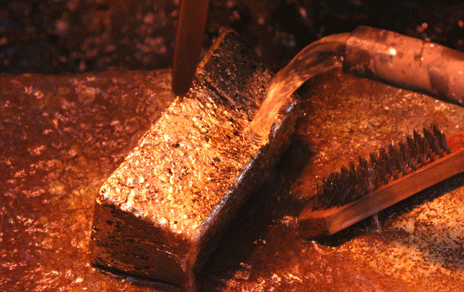LONDON, April 15 (Reuters) - U.S. President Donald Trump's tariffs blitz has left Doctor Copper battered and bruised.
Last week's copper chaos was of course just a small part of the global turmoil as markets gyrated to the frenetic beat of Trump's changeable tariffs policy.
But in copper's case, which owes its nickname to its ability to diagnose the health of the broader economy, tariff calculations are doubly complicated. The market is trying simultaneously to price in both the broader tariff threat to global manufacturing activity and the specific threat of U.S. tariffs on copper imports.
Outright price turbulence overlays a re-configuration of the physical supply chain as traders ship copper to the United States to beat the unknown tariff deadline, which is starting to tighten up availability everywhere else, including in China.
WILD RIDE
London Metal Exchange (LME) three-month copper slumped to a 17-month low of $8,105 per metric ton on April 7 after China responded to U.S. tariffs in kind.
The subsequent 90-day reduction of U.S. tariffs on everyone but China and a reprieve for electronic goods have generated an equally violent price correction back above the $9,000-per ton level.
LME time-spreads have flipped from contango to backwardation and back to contango.
The arbitrage between the LME price and the U.S. price traded on the CME has been particularly wild. The CME premium over the London price collapsed from $1,600 per ton at the start of April to just $230 per ton on April 8 but has since rebounded back above $1,000.
The violence of the moves suggests forced unwinds of futures, spreads and arbitrage positions. The roller-coaster ride was evidently just too scary for some punters.
TARIFF BLUES
Copper's initial reaction to Trump's tariffs tells you how negative the market thinks the potential hit to manufacturing activity and copper demand will be.
Analysts have moved quickly to downgrade their price forecasts on concerns about the dampening effect on global economic growth.
Citi, which now expects copper to hit $8,000 per ton over the next three months, warns that commodity markets are still not pricing the full potential impact on demand.
There are "some corollaries" with the downward deflationary spiral of 2015, when copper fell as low as $4,000 per ton, the bank said in an April 7 research note.
The truth is that no-one really knows which way Trump's tariff roulette wheel will spin next. That uncertainty is itself a negative for the copper price.
ON A FAST BOAT TO THE UNITED STATES
Copper is excluded from Trump's reciprocal tariffs but that is probably because the White House is awaiting the results of its Section 232 national security investigation into U.S. imports of the metal.
Administration officials have hinted copper tariffs will come sooner rather than later but until a formal announcement the race is on to move as much metal as possible to the United States to beat the deadline.
The resulting rejig of the physical supply chain is now becoming increasingly evident.
CME stocks are rising with copper flowing daily into exchange warehouses in New Orleans. CME warehouses in Baltimore last week received 6,614 short tons (6,000 metric tons) of metal in what was the first activity at this location since 2012.
Headline CME inventory of 119,772 short tons is now at its highest level since December 2018 and still rising.
LME stocks, by contrast, have been declining since February, touching a 9-month low of 207,825 metric tons at the end of last week.
On-warrant inventory was just 116,250 tons, reflecting the large volume of metal currently awaiting physical load-out to fill potential supply chain gaps opened up by the gravitational pull of the U.S. copper premium.
CHINESE STOCKS PEAK EARLY
That drag effect is extending as far as China.
Shanghai Futures Exchange (ShFE) copper stocks always spike higher over the Lunar New Year holiday period and this year was no exception.
But the February peak of 268,337 metric tons was both lower and shorter-lived than last year, when the holiday surplus lasted all the way through to June.
ShFE stocks are now falling fast again, declining by almost 43,000 tons to 182,941 tons last week.
The Yangshan premium, a closely-watched indicator of the country's import demand, has jumped from a February low of $35 to $87 per ton.
The optics suggest tightening availability in China, although this may ironically be down to Chinese smelters exporting more to try and get in on the U.S. copper tariff trade.
Chinese exports of refined copper almost doubled year-on-year to 50,000 tons in January and February, including 1,200 tons shipped directly to the United States.
TARIFF TENSION
Copper's micro and macro dynamics are pulling in opposite directions, albeit for the same reason.
Copper as a macro play cannot but reflect the broader market concerns about the negative impact of an escalating trade war between the United States and China on the world economy.
But at a micro level, the specific threat of U.S. tariffs on the metal is pulling normal trade patterns out of shape and causing both LME and Shanghai exchange inventories to fall.
Macro and micro will be reconciled over time but the clash of tariff impacts promises more volatility ahead.
Stay buckled up. The roller-coaster ride isn't over yet.
The opinions expressed here are those of the author, a columnist for Reuters.
Editing by Tomasz Janowski
